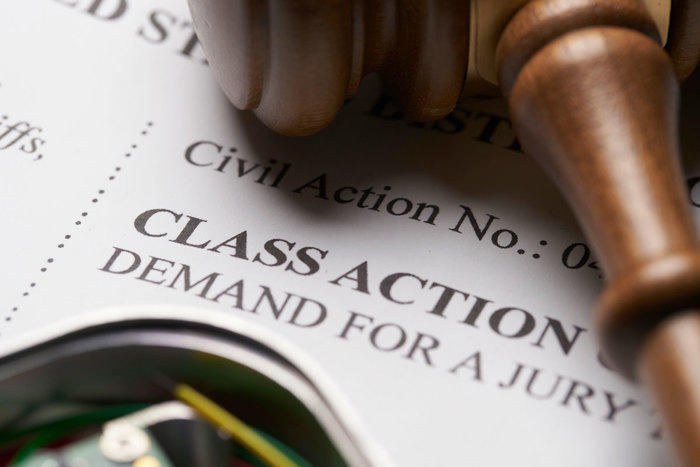Insights right into the Future FinTech Class Action Lawsuit: Remain Informed
Discovering Course Activity Claims: What You Required to Know
Class activity legal actions have actually ended up being progressively prevalent in today's lawful landscape, with individuals joining pressures to look for redress versus organizations and firms. In this conversation, we will check out the ins and outs of class activity lawsuits, dropping light on their meaning, the demands for filing, and the prospective benefits and disadvantages included.
The Interpretation of Class Activity Lawsuits
Exactly what is the meaning of a class action suit? A class activity legal action is a legal action filed by a group of individuals who have similar claims versus an offender. It allows a a great deal of people, recognized as the class members, to collaborate and seek their insurance claims collectively, instead of each individual declaring a separate suit. Class activity suits are typically brought when the number of possible plaintiffs is too big for private lawsuits to be practical. They are typically made use of in situations entailing consumer security, product responsibility, protections fraud, and employment issues.
One of the crucial elements of a course activity legal action is that the lead complainant, also recognized as the course agent, represents the rate of interests of all the course members. The court designates the lead plaintiff based upon their ability to rather and properly represent the course. The lead plaintiff works very closely with the course activity attorney to build a strong case and seek settlement or other solutions in behalf of the entire course.
In order for a class activity claim to continue, the court has to license the class. This implies that the court figures out that the claim fulfills particular demands, such as numerosity (a huge adequate variety of class members), commonness (common questions of law or fact), typicality (the insurance claims of the lead complainant are normal of the course), and adequacy of representation (the lead complainant and course guidance are qualified of standing for the class's passions) Once the course is accredited, the claim can relocate onward, and any judgment or settlement reached will put on all course members unless they pick to opt-out.
Class activity claims serve a vital purpose in supplying accessibility to justice for people that might not have the sources to seek their cases independently. They likewise advertise efficiency in the lawful system by consolidating similar insurance claims right into a solitary activity, decreasing the concern on both the court and the parties entailed.
Needs for Filing a Course Action Lawsuit

An additional requirement is that the course must be completely many. The specific variety of class members required may vary depending upon the jurisdiction and the nature of the case. It is generally expected that the class has to be huge sufficient that signing up with all the private complainants into a solitary claim is a lot more reliable than having multiple separate lawsuits.
Additionally, it is crucial that the class rep, who is the specific or entity bringing the claim on behalf of the class, has common claims and defenses to those of the course members. The representative should additionally be able to adequately and fairly represent the interests of the whole course.

Advantages and Drawbacks of Course Action Legal Actions
Course action lawsuits supply both benefits and disadvantages for complainants and defendants included in the lawful procedure. On the one hand, one of the significant benefits of course activity lawsuits is that they provide a efficient and affordable method for individuals with comparable claims to seek justice jointly. By settling various comparable cases right into one lawsuit, course actions streamline the lawful procedure and conserve time and resources for both plaintiffs and accuseds.
Another benefit of class action claims is that they allow people with restricted sources to seek payment for their problems. In cases where the possible recovery is little, individual lawsuits may not be economically practical. However, by signing up with pressures in a class action, complainants can pool their sources and increase their chances of obtaining a fair resolution.
Furthermore, course activities can promote social modification by holding firms answerable for their activities. By bringing attention to prevalent transgression or faulty items, class activities can pressure firms to change their techniques, enhance product security, or carry out reforms.
However, class activities likewise have drawbacks. One prospective disadvantage is that specific plaintiffs may have limited control over the litigation procedure and the ultimate outcome of the situation. The lead complainants and their attorneys commonly make vital decisions on part of the whole class, which might not always straighten with the individual rate of interests of each class participant.
Additionally, course activities can be extensive and time-consuming, often taking years to reach a resolution. The complexity and size of these claims can cause delays and extended litigation, which can be frustrating for both complainants and offenders seeking a timely resolution.
Actions Associated With a Course Action Legal Action
The process of a class action legal action typically starts with the identification of a potential class and the filing of a problem. When a group of individuals that share comparable cases against an accused is identified, the lead plaintiff, or course agent, submits a grievance in behalf of the whole course. This complaint lays out the claimed misdeed and seeks damages or various other relief for all participants of the class.
After the problem is filed, the court will certainly determine whether the situation meets the requirements for course certification. These requirements generally include numerosity (a huge adequate class), commonality (comparable legal claims), typicality (the lead complainant's insurance claims are representative of the course), and competence of representation (the lead plaintiff and their attorney can effectively represent the class's interests)
If the court accredits the class, notification is provided to all potential class participants, providing the possibility to opt-out if they desire to seek their very own individual cases - BioVie class action lawsuit. If an enough number of class participants remain, the case will certainly proceed to the exploration phase, where both sides gather proof and info pertinent to the Resources cases
Complying with discovery, the parties may involve in settlement negotiations or continue to test. If the situation goes to test and the course prevails, the court will certainly identify the proper damages or relief to be granted to the course members.
Current Landmark Course Action Claims
With a solid understanding of the actions entailed in a class activity legal action, it is now vital to check out check it out some current site instances that have actually made a considerable impact in the lawful landscape. Assertio class action lawsuit. These situations have not only formed the method course activity legal actions are conducted but have actually also caused modifications in various industries
One such site case is the Volkswagen discharges detraction, which led to the largest class activity settlement in vehicle background. This deceptiveness affected millions of customers worldwide, leading to a class action legal action.
An additional remarkable case is the Johnson & Johnson talc suit. Hundreds of females submitted lawsuits versus the firm, asserting that their talcum powder products triggered ovarian cancer. In 2018, a jury granted $4.7 billion in damages to 22 plaintiffs. This situation raised problems regarding the safety of baby powder and motivated Johnson & Johnson to modify their product labeling.
These current site instances demonstrate the power of course action suits in holding corporations liable for their activities and seeking justice for afflicted people. They act as examples of how course activity legal actions can cause considerable changes and secure the rights of customers.
Final Thought
To conclude, class activity legal actions are a lawful system that enables a team of people to jointly seek justice for an usual complaint. While they offer several advantages such as effectiveness and cost-effectiveness, there are additionally downsides such as potential for minimal settlement and prolonged lawful proceedings. Comprehending the steps and requirements associated with filing a class activity lawsuit is important for people looking for to pursue this lawful opportunity. Current spots course action suits have highlighted the relevance of such cases in advocating for customer legal rights and company accountability.
One of the crucial components of a course activity lawsuit is that the lead complainant, also understood as the course representative, stands for the rate of interests of all the class participants.In order for a class action suit to proceed, the court must certify the class. This indicates his comment is here that the court identifies that the lawsuit satisfies certain needs, such as numerosity (a large sufficient number of class participants), commonality (typical inquiries of regulation or fact), typicality (the claims of the lead complainant are regular of the course), and adequacy of depiction (the lead plaintiff and class counsel are capable of standing for the class's passions) As soon as the class is certified, the claim can relocate onward, and any judgment or negotiation reached will use to all course members unless they choose to opt-out.
The procedure of a course action claim generally starts with the identification of a potential course and the declaring of a grievance.